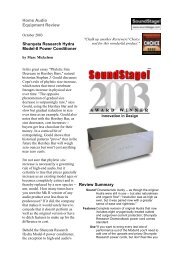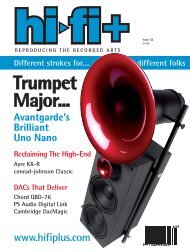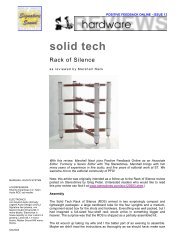tas143p - Audio Note Singapore
tas143p - Audio Note Singapore
tas143p - Audio Note Singapore
You also want an ePaper? Increase the reach of your titles
YUMPU automatically turns print PDFs into web optimized ePapers that Google loves.
equipment<br />
report<br />
Air-Tight 211 SET Monoblock Amplifiers<br />
Scot Markwell<br />
Sometimes, amplifiers with<br />
simple circuits manage to<br />
capture more of the essence<br />
of music than those with<br />
more complex ones; the Air-<br />
Tight 211 single-ended triode (SET)<br />
monoblock is such an amp. It belongs in<br />
the top echelon of the SET amplifiers I’ve<br />
heard in the four years or so of I’ve been<br />
researching and listening to the breed.<br />
The Air-Tight amplifiers came to me<br />
while I was auditioning several other SET<br />
designs, along with a few high-sensitivity<br />
speaker systems, so I was able to compare<br />
them to other amps of similar power<br />
and price, as well as lower and higherpowered<br />
designs. More importantly, having<br />
several compatible speaker systems<br />
around gave me the chance to hear how<br />
these amplifiers reacted to differing loads.<br />
I want to stress right upfront that anyone<br />
interested in seriously pursuing SET<br />
amplifiers, whether an inexpensive<br />
design or a more upscale set such as the<br />
211s, needs to accept the fact that these<br />
are special amplifiers that require careful<br />
loudspeaker matching. Remember that a<br />
sensitive speaker can be easily driven by<br />
almost any amplifier, but a SET, with<br />
very rare exception, must be partnered<br />
with a high-sensitivity loudspeaker to<br />
play music at natural levels without gross<br />
distortion and compression of the signal.<br />
Despite what some marketing types may<br />
tell you, what is really necessary for SET<br />
amplifiers up to about 30 watts per channel<br />
are speakers with a sensitivity of at<br />
least 92dB/watt and an impedance curve<br />
that does not dip below 6-8 ohms, especially<br />
in the bass.<br />
Because of these limitations, a lot of<br />
audio folks have declared SET designs<br />
obsolete, but the truth is that restrictive<br />
loudspeaker matching is neither a bad<br />
thing nor an encumbrance. If one wants<br />
to enjoy the many sonic benefits,<br />
charms, and sexiness of SET amps, then<br />
there is only one way to go with speakers—and<br />
this is just the way it is.<br />
It used to be, even a few years ago,<br />
that some of the speakers that functioned<br />
best electrically with these amps<br />
were among the worst sonically. But<br />
today things are much better. The quality<br />
of SET sound I’ve heard with speakers<br />
like the Reference 3A Royal<br />
Virtuosos or the Living Voice Avatar<br />
OBXs that I now use—or the Horning<br />
Alkibiades Signature Golds, Coincident<br />
Total Eclipses, or Lamhorn 1.8s I’ve used<br />
in the past—can be superb, on a par<br />
with the many conventional loudspeakers<br />
that must be used with higher-powered<br />
amplifiers. While none of these<br />
high-sensitivity speakers was or is perfect,<br />
all were superior communicators of<br />
music with low coloration; all sounded<br />
life-like enough to make me want to<br />
keep listening for extended periods,<br />
without fatigue or dissatisfaction.<br />
With appropriate system matching,<br />
the Air Tight 211s offer a level of performance<br />
that easily makes one forget<br />
about the laws of physics and just relax<br />
and listen to music. The basic character of<br />
the 211s entails a fully-developed dimensionality<br />
and a tonal balance that, though<br />
warm and inviting, is refreshingly free of<br />
many of the “traditional” SET deviations<br />
from neutrality that mar many of even<br />
the most revered designs. Virtually<br />
unique in my experience of SETs is the 3-<br />
D quality these amplifiers exhibit, especially<br />
with LPs. With the best recordings,<br />
the 211s develop a soundstage depth and<br />
lateral spread that ranks with the top two<br />
or three SETs I’ve heard—indeed, with<br />
the best amplifiers I’ve heard.<br />
Along with this soundstage prowess<br />
comes an ability that I have not heard<br />
elsewhere to such dramatic effect, one<br />
that is riveting both musically and sonically:<br />
When presented with high-fre-<br />
WWW.THEABSOLUTESOUND.COM 77
equipment<br />
report<br />
quency transient information such as<br />
cymbal crashes or synthesizer chords,<br />
like the big “splashes” of cymbal-like<br />
information on Frankie Goes to<br />
Hollywood’s Relax (Island UK, 45rpm<br />
LP), this amplifier projects a huge,<br />
almost enveloping cloud of intense<br />
high-frequency “mist.” The effect is<br />
akin to being in near proximity to a<br />
steam valve on a big boiler as it lets off<br />
pressure; it is as if a big wall of steamhiss<br />
suddenly appears, larger-than-life,<br />
before your eyes and ears, and then fades<br />
away with no carry-over or heaviness—<br />
just a massive jolt of high-frequency<br />
information that suggests space and<br />
three-dimensional volume and extended<br />
treble response. Synthesizer tones and<br />
effects are, of course, hard to describe,<br />
but I can’t help feeling that what I was<br />
hearing was what the record producer<br />
intended me to hear.<br />
Such performance at the upper end of<br />
the frequency spectrum would be worthless<br />
if the midband and bass were not as<br />
well served. Happily they are. As a matter<br />
of fact, the midrange and bass of the<br />
Air Tight 211s form a sonic cloth cut<br />
from the same seamless bolt as the highs.<br />
Many times the excellent midrange performance<br />
of SET amps comes at the cost<br />
of extension at the frequency extremes,<br />
and what performance they do have at<br />
either end is usually colored and typically<br />
a bit sloppy and ill-defined. The 211<br />
is different in that, with any of the speakers<br />
I tried, both the bass and treble<br />
remained solid and reasonably flatsounding<br />
and well-integrated into the<br />
overall presentation. No band of frequencies<br />
really stands out from the others,<br />
with the exception of the extreme highs,<br />
where occasionally really high overtones<br />
can sound slightly exaggerated or spotlit.<br />
So sweet and low in distortion is the<br />
upper-octave response of the 211s, however,<br />
that I never felt this to be a problem.<br />
On the contrary, I was more struck<br />
by a sense of openness and unfettered<br />
dynamic and dimensional response. If I<br />
had to choose, I would much rather hear<br />
highs reproduced with such smoothness<br />
and vigor than to hear them rolled off or<br />
dynamically deadened.<br />
These amplifiers have the punch to<br />
back up their dynamic authority. Rated<br />
at twenty-two watts of Class-A power<br />
per monoblock, the 211s are near the<br />
upper limit of what can normally be<br />
done with a single output tube in a<br />
Class-A SET design. Of the amps I had<br />
on hand for this review, their only real<br />
competitors were the Vaic VV 52B<br />
stereo integrated amp at 30 watts per<br />
side and the Ayon 32B Classic<br />
monoblocs at 20, but that is a negligible<br />
78 THE ABSOLUTE SOUND ■ AUGUST/SEPTEMBER 2003
equipment<br />
report<br />
power difference and in practice virtually<br />
impossible to hear in terms of output<br />
level at the loudspeaker. The Vaic, at<br />
approximately the same price, exhibited<br />
a slightly weightier and powerful<br />
extreme bottom end and a similarly<br />
extended treble, but did not have the<br />
refinement and seductive sweetness of<br />
the 211s. The Ayon amps were actually<br />
quite similar, although slightly leanersounding<br />
in the midbass than the 211s.<br />
Big, big records like The Human<br />
League’s Don’t You Want Me Baby<br />
(Virgin UK, 45pm LP) or David Bowie’s<br />
“Theme from Cat People” (Putting out<br />
Fire [Backstreet 45rpm LP]) feature<br />
awesome, powerfully deep, and loudly<br />
recorded bass notes on drums and synthesizers<br />
that can terrorize most SET<br />
amps. But with either the 3A Royal<br />
Virtuosos or the Living Voice Avatar<br />
OBXs, the Air Tight amps just sailed<br />
through the peaks and delivered the<br />
goods. The last half of the bottom octave<br />
seemed to be somewhat rolled off, but I<br />
imagine that could be addressed with<br />
speaker placement closer to the rear<br />
wall. That is a setup I preferred not to<br />
use, as I am biased towards the depth<br />
and dimensionality I get with placement<br />
well out into the room—in my case<br />
about three to four feet out.<br />
I found I could listen without strain<br />
to well over 100dB peaks in my goodsized<br />
room (approx. 18’ x 10’ x 8’ with<br />
lots of damping) and not hear any hint of<br />
compression or strain right up to the<br />
211s’ considerable power limit. Digital<br />
fare like the Gladiator soundtrack on CD<br />
[Decca/Universal], or perhaps the Glory<br />
soundtrack on Classic Record’s 96/24<br />
DAD, definitely pushed the 211s to that<br />
limit when played loudly, but the sonic<br />
picture remained coherent right up to<br />
the point of clipping. Unlike many<br />
higher-powered tubed amplifier designs,<br />
where the onset of clipping is usually<br />
heard as a general distortion and raggededge<br />
to the sound that can be reduced by<br />
just dropping the volume a bit, hard<br />
clipping on an SET amp is most often<br />
characterized by an abrupt blatting<br />
noise in the bass and an acutely uncomfortable<br />
out-of-control sound in the<br />
midrange, especially on vocals. This is<br />
not to say that the Air Tight 211s react<br />
any differently that other SETs when<br />
pushed past their limits, only to note<br />
that these limits are reasonably high<br />
with the right speakers.<br />
When matched with such speakers,<br />
the 211s are magical in the best tradition<br />
of SETs. Sweet, grainless, and<br />
blessed with both the creamy, emotionally<br />
expressive, and slightly projected<br />
midrange of better SET designs, as well<br />
as relatively potent bass and dynamic<br />
authority, the Air Tights make a strong<br />
case for their kind. With the $4000/pair<br />
3A Royal Virtuosos, the 211s have truly<br />
wide dynamics and superb high-frequency<br />
extension, with a fully-fleshed<br />
midrange that lends a sense of listening<br />
with no “roof” on the sonic proceedings.<br />
Although bass information is well-rendered,<br />
the amplifiers are taxed when<br />
asked to reproduce gargantuan organpedal<br />
notes and deep synthesizer rumblings.<br />
But the six-to-eight ohm, directdrive,<br />
crossover-less mid/woofer of the<br />
3A presents the 211s with a super-easy<br />
load to drive (no heat or power wasted<br />
battling a crossover network). The onpaper<br />
higher-sensitivity (94dB/watt)<br />
$7000/pair Living Voice Avatar OBX<br />
have a balance somewhat similar to the<br />
3As, but tend towards a slightly leaner<br />
and less voluptuous sound, albeit one<br />
with slightly greater bass extension.<br />
I also tried the 211s with the new<br />
$4000/pair Alón Lotus Elite speakers, a<br />
design that has evolved from the original<br />
Lotus of a few years ago (a speaker of<br />
about 90dB/watt and with a 14-ohm<br />
woofer designed specifically for SET<br />
amps) to a dual-woofer, more conventional<br />
three-way speaker, designed optimally<br />
for a bit more power than that 211<br />
has. However, played within their limits,<br />
the Air Tight amps displayed a<br />
remarkable affinity for the Alóns, making<br />
a bigger and slightly warmer sound<br />
than they did with the other two speakers,<br />
with truly remarkable bass authority<br />
and extension. The Alóns were, in<br />
many respects, the best match for the<br />
211s, but their more complicated<br />
crossover and lower sensitivity (around<br />
89dB/watt) necessitated tighter control<br />
of the volume knob.<br />
I have thoroughly enjoyed my time<br />
with the Air Tight 211 amplifiers. The<br />
$9995/pair 211s have more than enough<br />
juice to drive sensibly-chosen speakers<br />
and, while by no means inexpensive, are<br />
not overpriced for the sound they deliver.<br />
Their refined, smooth, extended, dimensional,<br />
and dynamically authoritative<br />
presentation make them a very attractive<br />
choice for someone looking to assemble a<br />
superior SET-based system that will not<br />
suffer from most of the limitations of the<br />
Air Tight’s lower-powered brethren. &<br />
SPECIFICATIONS<br />
Power output: 22 watts Class A<br />
Dimensions: 15.3" x 10.3" x 14"<br />
Weight: 55 lbs.<br />
ASSOCIATED EQUIPMENT<br />
VPI HW-19 MK IV turntable w/VPI JMW<br />
Memorial 10.5 arm; VPI Aries Scout<br />
turntable w/VPI JMW 9 Memorial arm; Benz<br />
LP, Clearaudio Harmony Wood, Clearaudio<br />
Insider Reference Wood, and Madrigal<br />
Carnegie 1 MC cartridges; Plinius M-14 MC<br />
(solid state) phono section and Hagerman<br />
Technologies (tubed) MM phono section with<br />
VAC step-up transformer; Plinius M-16 (solidstate)<br />
and Emotive <strong>Audio</strong> Sira (tubed) line<br />
stages; Viva 300B, Vaic VV 52B, and Ayon<br />
32B Classic SET amplifiers; ART <strong>Audio</strong> Opus<br />
X push-pull tubed monoblock amplifiers; Cary<br />
Rocket 88 triode/push-pull tubed amp,<br />
Forsell Air-Bearing CD Transport and EAD<br />
Theatermaster DAC; Reference 3A Royal<br />
Virtuoso, Living Voice Avatar OBX, and CAS<br />
SM-50 loudspeakers; SLM/Janis subwoofer<br />
with VBT subwoofer amplifier; Alón<br />
Thunderbolt subwoofer; Siltech Gen III, <strong>Audio</strong><br />
Magic, and Stealth Technologies interconnects<br />
and loudspeaker cabling, Arcic<br />
Suspense Rack.<br />
DISTRIBUTOR INFORMATION<br />
Axiss Distribution, Inc.<br />
17800 South Main Street, suite 109<br />
Gardena, California 90248<br />
(310) 329-0187<br />
www.axiss-usa.com<br />
Price: $9995/pair<br />
WWW.THEABSOLUTESOUND.COM 79


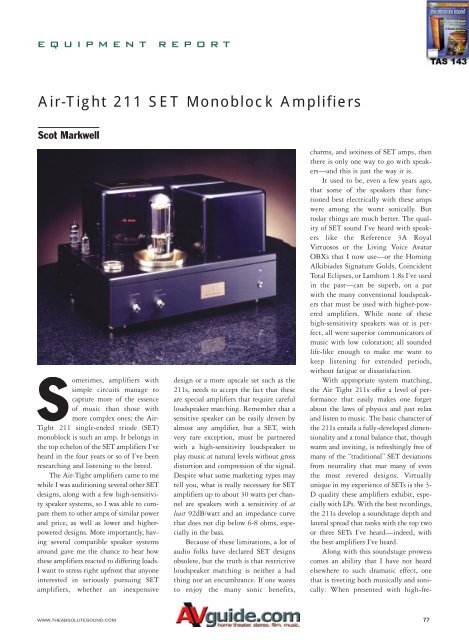
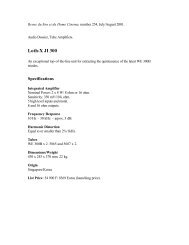
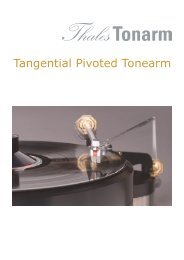
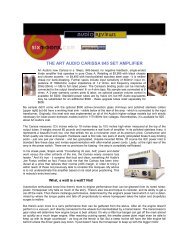
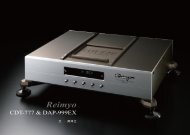
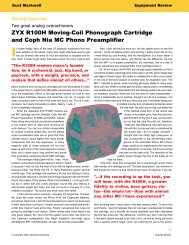
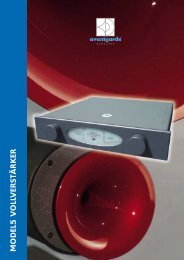
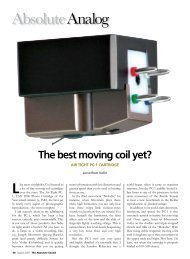
![DAP-999 EX Limited [pdf] - Audio Note Singapore](https://img.yumpu.com/27191044/1/190x253/dap-999-ex-limited-pdf-audio-note-singapore.jpg?quality=85)
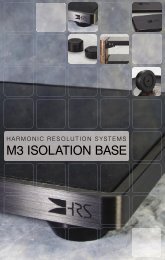
![Harmonix CS-120 Improved-Version [pdf]](https://img.yumpu.com/24411255/1/184x260/harmonix-cs-120-improved-version-pdf.jpg?quality=85)
